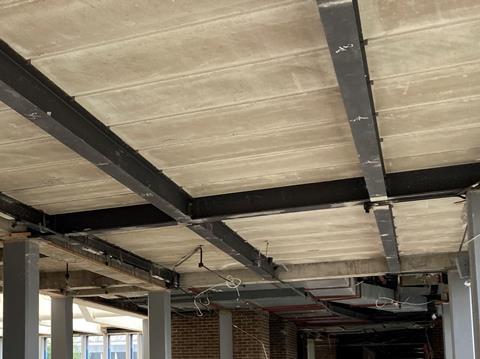Government publishes updated list following fresh surveys of NHS estate in England
The number of hospital sites confirmed to be affected by unsafe concrete has increased by more than 40% in the past six months.
Surveys ordered by the government in May have uncovered 18 more hospitals sites which contain reinforced autoclaved aerated concrete (RAAC), bringing the total to 42.
The Department of Health and Social Care (DHSC) has published an updated list of the sites now included in NHS England’s ongoing RAAC programme, which has been given £698m in funding for trusts to put remediation and failsafe measures in place.
The new sites have been identified using new guidance from the Institution of Structural Engineers, and join the programme regardless of the extent to which RAAC is present or whether it is found in clinical or non-clinical spaces.

“Where possible RAAC is identified, visual inspections and structural surveys take place to verify its presence and level of risk,” DHSC said.
“Once the presence of RAAC is confirmed, trusts join the national RAAC programme. This programme supports mitigation, remediation and wider planning to maintain safety.”
Three sites have entirely eradicated previously confirmed RAAC and have left the programme, while seven hospitals that are most affected are part of the government’s New Hospital Programme for full rebuilding by 2030.
Julian Hartley, chief executive of NHS Providers, which represents NHS trusts across England, said: “This old concrete puts patients and staff at risk and the picture is getting worse.
“We feared that even more of this unsafe material would be found in hospitals and NHS buildings by government-ordered surveys.
“Trusts are doing everything they can, at huge cost, to keep patients safe where this concrete is found.
Hartley said the presence of RAAC in hospitals is a “symptom of a far bigger and long-running” problem.
”The NHS has a £10bn-plus backlog of repairs as it struggles to maintain too many creaking, leaking and outdated facilities and buildings.
More on RAAC
>>How do we fix England’s crumbling school estate?
>>Review your contracts for potential RAAC liabilities
>>Scandal over RAAC school closures points to a deeper malaise
“Concerns about the NHS estate go far beyond RAAC. Many trusts still need major investment to refurbish ageing buildings and tackle other risks to the safety of patients and staff.”
Meanwhile, the concrete has forced two more colleges to close, according to the Department for Education (DfE).
More than a 100 schools were told to shut or restrict RAAC-affected areas at the end of August after the government found “new evidence” on the concrete suggesting it was more dangerous than previously thought.
The DfE says there are now 214 schools and colleges with confirmed cases of RAAC, up by 41 since the last list was published in late September.
Camborne College, which is part of Cornwall College Group, and Peterborough College, which is part of Inspire Education Group, have been added to the list, although the DfE said all six colleges on the list have kept their students in face-to-face education.
The University of East Anglia also closed its grade II*-listed student accommodation buildings, known as the Ziggurats, in September and moved students to alternative sites after finding RAAC.



























No comments yet